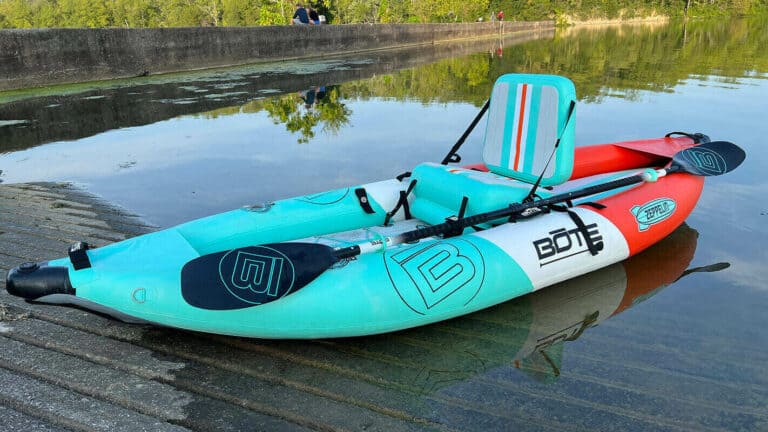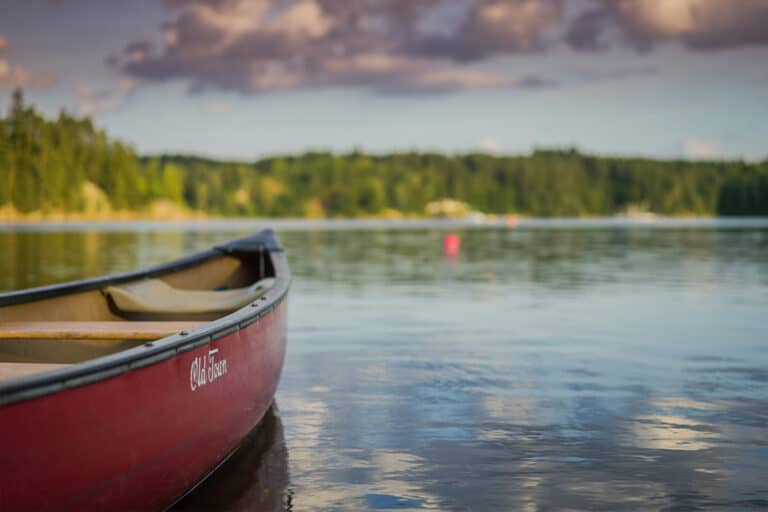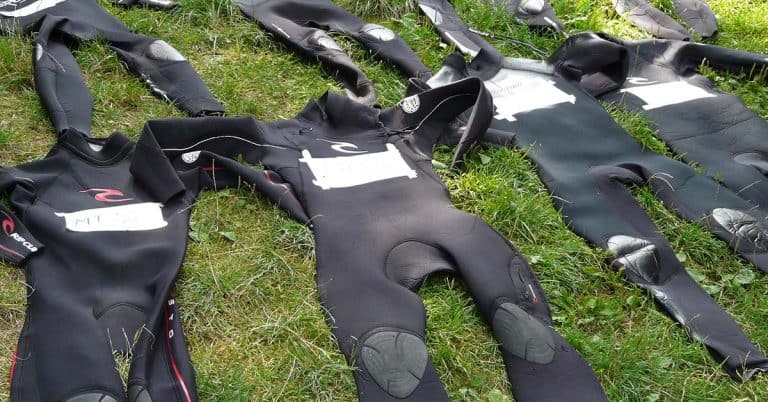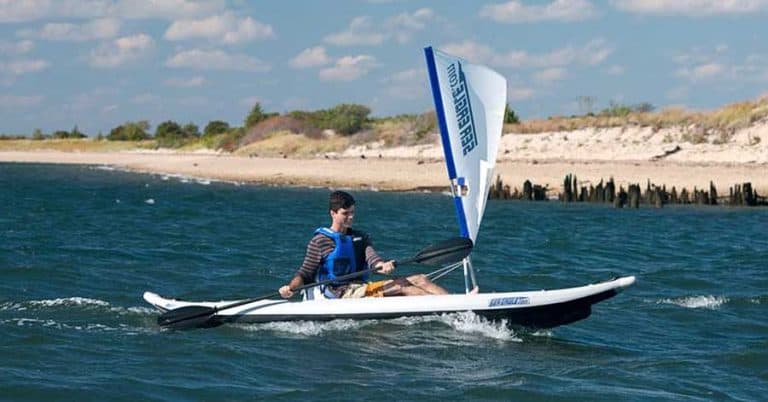Disclosure: I am compensated for purchases made through some links on this site. Click for details.
The longevity and safety of inflatable kayaks are tied to the boat’s durability. Before you buy an inflatable kayak, it’s important to know how well these boats hold up to rocks, limbs, and other debris.
Ever wonder if inflatable kayaks puncture or pop easily?
Quality inflatable kayaks don’t pop easily nor do inflatable kayaks tear or puncture easily. The durable materials and manufacturing processes used in developing inflatable boats yield high-quality kayaks that are resistant to punctures or tears.
It’s a common misconception to think of an inflatable kayak as being inferior to a hardshell kayak. This is far from the truth.
The design features of inflatable kayaks, like Sea Seagle Boats, often make them superior to hardshell kayaks. Inflatables handle hits much better than hardshell kayaks that experience oil canning. Oil canning is a term used to describe the hull indentations that occur in many hardshell kayaks.
Let’s look at the materials and manufacturing that go into inflatable kayaks and why they are resilient boats that resist popping, punctures, or tearing.
Determining Inflatable Kayak Durability

Inflatable Kayak Durability and Price
Inflatable kayak durability and price typically go hand-in-hand. There are cheaply made inflatable kayaks that are a waste of your time and money and there are high-quality inflatable kayaks designed to resist punctures and designed to last.
Some of the best kayaks for the money are from Sea Seagle Boats. They make some of the highest quality inflatable kayaks on the market. No matter what your style of kayaking, they have a boat for you.
Related Content: Design Features To Look For In An Inflatable Kayak
Inflatable Kayak Durability and Boat Category
Like all kayaks, inflatable kayaks are designed according to use. Buying the right category has a determination in its durability.
Which Category of Inflatable Kayak Meets Your Style?
- Inflatable recreational kayaks are shorter in length (around 12ft or less) and wider for stability. They are comfortable boats designed for light touring on lakes and rivers from gently flowing to Class I or II rapids. Their versatility makes them great entry-level boats for anyone who’s unsure of what type of paddling they’ll be doing in the future and for anyone interested in a multi-use kayak.
- Inflatable touring kayaks (flatwater kayaks) are specifically designed for paddling longer distances on flat water. These long, narrow kayaks easily glide through the water with the aid of rudders or tracking fins to achieve advanced control and tracking.
- Inflatable whitewater kayaks are short and wide with no tracking fin. The shape allows for maneuverability in Class 1 to Class IV rapids.
An inflatable kayak is more likely to be punctured, popped, or torn if used in the wrong water. For safety and the longevity of your inflatable kayak, be sure to buy according to the type water you’ll be kayaking.
Related Content:
Inflatable Kayak Durability, Design, and Materials
The design features and materials of inflatable kayaks differ between manufacturers and the different models, categories, and styles of kayaks.
High-quality, inflatable kayaks are made of extremely durable materials like Pennel Orca®, HD40 gum, AIREcell urethane, denier ripstop polyester, and aluminum frame reinforcement to protect from punctures and abrasion.
Construction techniques like PVC welded seams and poly-based fabric with drop-stitch construction improve durability and allow for higher inflation press for improved kayak performance.
Multiple inflation chambers improve the design of inflatable kayak. Separate inflation chambers make inflatable boats virtually impossible to sink. A cheap inflatable kayak with only one inflation chamber is a safety risk if punctured.
Let’s look at the design of inflatable kayaks and their materials in further detail…
Materials Used in Making Inflatable Kayaks
Ever wonder what inflatable kayaks are made of?
Here are some of the superior materials that can be found in high-quality inflatable kayaks…
- Pennel Orca® – Chlorosulfonated Polyethylene (CP) Rubber is a top-rated material developed by Pennel to coat Orca fabric used in making NRS inflatable kayaks. Pennel Orca stands up to rocks, scrapes, and harmful UV rays.
- Hypalon – DuPont’s name for chlorosulfonated polyethylene (CP). If you’re looking for a Hypalon boat, DuPont stopped making it in 2010. Pennel Orca is its replacement.
- HD40 gum – An anti-abrasion material used on the bottom of NRS Pennel Orca® boats.
- AIREcell urethane – Aire inflatable kayaks feature a thermal-welded internal bladder system made from 10 – 12 mil urethane film that’s covered with a heavy-duty PVC coated polyester fabric to protect against abrasion, wear, tear, and harmful UV rays.
- Denier Ripstop Polyester – Fabric with reinforced threads interwoven in a crosshatch pattern that resists tears.
- Aluminum Frame Reinforcement – Reinforcement available in select blow-up kayaks for the improvement of tracking. Inflatable touring kayaks often benefit from reinforced frames.
- Other Common Inflatable Kayak Materials are PVC, PVC-coated polyester, and vinyl.
Welded Seams and Drop-Stitch Construction in Inflatable Kayaks
Two ways boat manufacturers increase the structural integrity of inflatable kayaks is through the use of poly-based fabric with drop-stitch construction and PVC with thermal welded seams. These construction techniques allow for higher inflation pressures and air retention while also providing superior resistance to abrasion.
The process of creating drop-stitch materials starts by joining two layers of poly-based fabric with tens of thousands of fine polyester threads. This is the base layer to which an air-tight coating is applied. The process after inflation results in a flat, rigid surface that increases the performance of inflatable boats.
Thermal welding PVC is a process that uses pressure and heat to permanently bond seams together without the need for toxic glues that can degrade over time and from sun exposure.
Inflatable kayaks that use these construction technologies have superior durability, strength, and performance.
Air Chambers in Inflatable Kayaks
Top-rated inflatable kayaks have multiple inflation chambers for durability and safety. On the off chance the kayak is punctured or springs a leak, the remaining inflation chambers will keep you from sinking.
Thwarts in Inflatable Kayaks
Some inflatable kayaks have thwarts. Often removable or adjustable, these are cross supports that improve stability and act as seatbacks and footholds.
Air Valves Used in Inflatable Kayaks
Superior air valves reduce the chance of leaking. It’s worth noting, four air valves are often used in the manufacture of many top-rated inflatable kayaks:
- Leafield
- Summit
- Spring
- Twistlok
How to Repair an Inflatable Kayak if Punctured
What About Punctures? Modern inflatable kayaks are very durable and rarely need repair. They just don’t puncture easily but should you need to make a repair, it’s fast and easy.
If you’re out on the water and need an easy repair that bonds in minutes, look at the Patch N Go KwikPatch. Consider this to be a temporary patch to get you through the day.
For a more durable patch job, you’ll want to make the repair once you’re back home. I’d strongly suggest purchasing a repair kit recommended by your boat manufacturer or specific to your boat’s material like these repair kits at Sea Eagle.
A leak can be found by covering the target area with soapy bubbles and listening for escaping air. Out on an adventure and don’t have soap? Spit works well too.
For more, check out this short video from Sea Eagle. They also have a cool tip for using masking tape to keep your patch job super clean.






